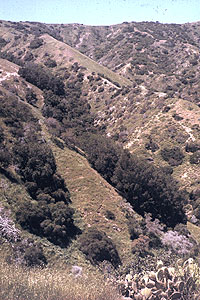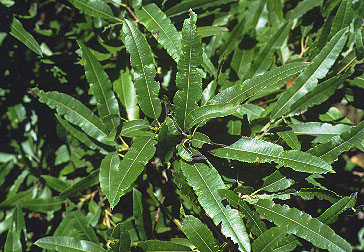
Catalina ironwood groves in Toyon Canyon
© 1997 Dr. Bill Bushing

Catalina ironwood groves in Toyon Canyon
© 1997 Dr. Bill Bushing
The Catalina ironwood (Lyonothamnus floribundus floribundus and the closely related Santa Cruz ironwood (Lyonothamnus floribundus asplenifolius are currently narrowly restricted endemics, limited in distribution to Catalina Island and to neighboring Santa Cruz, Santa Rosa and San Clemente Islands respectively. However, in previous geologic time, these two taxa had widespread distributions throughout the western United States during the Miocene based on fossil material dated 6 to 19 million years B.P. (Raven and Axelrod 1978, Wolfe 1964). It is interesting to note that the Santa Cruz form, currently found largely on the moister northern islands, had a more xeric interior distribution in the fossil record (Raven and Axelrod 1978).
Axelrod (1973) and Raven and Axelrod (1978) suggest that the ironwood was eliminated from the mainland United States due to climatic changes occurring during the late Miocene and Pliocene which resulted in a drier climate with less summer rainfall. For this reason these two taxa are referred to as relictual endemics or paleoendemics.
The two taxa are variously treated as subspecies (Raven 1963) or varieties of the
same species (Hickman 1993). They are the sole representatives of the genus.
Their taxonomy is uncertain in part because leaves in some of the groves on
Santa Catalina Island are known to exhibit leaf morphologies of both forms (Brandegee
1890, Jepson 1936). Currently, genetic studies are being undertaken to determine the relationship
between the two forms by Duff (1994) using isozyme analysis and Rancho Santa Ana
Botanic Garden (Timothy Ross, RSABG, pers. comm.) using PCR and RAPD techniques.

Leaves of the Catalina ironwood (Lyonothamnus
floribundus floribundus)
© 1997 Dr. Bill Bushing
Gustav Eisen first discovered Lyonothamnus on Santa Catalina Island in 1874. He sent samples to botanists in Europe, but they failed to note its taxonomic significance (Millspaugh and Nuttall 1923, Saunders 1926). In 1884 William S. Lyon collected specimens on the island and sent them to Asa Gray at Harvard who described the Catalina ironwood as a new species, naming it after Lyon (Gray 1885).
Formerly it was believed that the Catalina ironwood was incapable of producing viable seeds, and therefore reproducing sexually, due to its existence as a relictual endemic in a drier climate. Prior to 1990 there was only a single ironwood seedling documented from all the Catalina groves. The taxon's apparent low reproductive potential suggested the need for priority conservation efforts. Thorne (1967) referenced the impact of feral goats on Catalina ironwood groves, a situation mirrored on neighboring San Clemente Island prior to the removal of feral goats there (Raven 1963). Ironwood seedlings have weak stems and are therefore susceptible to trampling as well as grazing (Hall 1910, Junak 1987).
Following substantial reductions in feral goat populations on the island's West End in the early 1990's, numerous seedlings appeared in several of the ironwood groves there. In addition, many of the groves are exhibiting vegetative reproduction in the form of basal sprouting now that goat grazing pressure has been reduced. These observations, and their correlation with goat removal, are anecdotal and possibly coincidental as no specific scientific baseline studies were undertaken for comparison.
Fire is another potential threat to ironwood groves (Junak 1987). Fortunately, there has been relatively little fire during Catalina's post-European contact history. Undoubtedly this is due in part to reduced fuel loading due to goat grazing, so fire may become more of a threat in the future. There are indications of fire history in some of the ironwood groves based on observations of charred stumps (Mark Duff, pers. comm.).
Although previously speculated (Brandegee 1888, Hall 1910, Leishman 1981 and Junak 1987), Duff (1994) found that the Catalina ironwood groves tend to be clonal in nature, suggesting that their genetic diversity would be much lower than expected. Plant taxa with limited geographic ranges and small, isolated populations, and limited genetic diversity pose significant conservation challenges (Barrett and Kohn 1991).
Ironwoods tend to produce large quantities of seed. However, based on germination tests at the Santa Barbara Botanic Garden, only a small percentage of ironwood seeds are viable (Junak 1987). Juliano (1931) and Banwar (1966) noted that most seeds they examined were not viable. Duff (1994) suggested that low viability may indicate the need for genetic crossing for success. If true, new seedlings may represent significant additions to the genetic diversity of the taxon. Clonal populations like Catalina's ironwood groves, isolated from other genetic stock, may produce high rates of non-viable seed. This poses addition conservation problems for the taxon. It will be important to look at seed viability relative to grove genetics, pollination ecology and other issues to ensure the ironwood's survival over the course of time.
Although earlier mapping efforts (Minnich 1980) recorded only 40 ironwood groves on Santa Catalina Island, it is believed there may be as many as 200 groves present (Terry Martin, former Conservancy naturalist, pers. comm.). Our current ironwood maps show more than 100 of these groves.
In an early application of GIS technology, Junak (1987) investigated the distribution of the related Lyonothamnus floribundus asplenifolius on Santa Cruz Island. Junak found that this subspecies of ironwood was associated with specific geologic substrates, geologic features such as contact zones, north-facing slopes, a limited elevation range (180-380 m) and slopes from 15-29 degrees.
 Return to main text
Return to main text